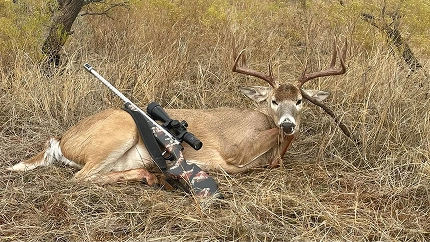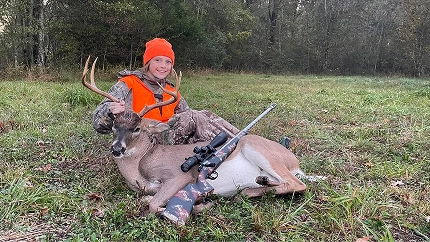Loading a Custom Smokeless Muzzleloader is similar to a regular inline muzzleloader, but there are some differences that we will discuss here. One difference is we need to size the bullet to ride the lands of the barrel, so you’ll need a reloading press and a bullet sizing die. If you don’t already reload, a simple Lee Precision hand press will work fine. We use a smooth form bullet sizing die from Hankins. The barrel on a .45 Brux barrel will measure close to .450” at the lands, and .458” in the grooves. You’ll want to pick your bullet 1st, and there are quite a few to choose from. We prefer Pittman Bullets, but have also used Fury Custom Bullets, and Parker bullets. There are quite a few .452 bullets that will work, some better than others depending on what you plan on using the bullet for.
Once you’ve selected your bullet, you’re ready to start to size them. Take the breech plug out of the muzzleloader, and take the muzzle brake off of the barrel. The clean barrel will be the gage for sizing the bullet. If you look at the sizing die, you’ll see machined dots around the body of the die, and there is also a reference mark line. These dots and mark are how you reference your adjustments when setting the die up. Now, with the die screwed into the press, you’ll put the bullet up in the die and run it through. Take the bullet and try to fit it into the end of the barrel, it won’t go in yet, so we need to adjust the die tighter. To adjust the die, use the supplied wrench to turn the top of the die body, paying attention to the dots and line for reference. Once adjusted, run the bullet through the sizing die, and try to fit it into the end of the barrel again. Repeat this process until the bullet will go into the end of the barrel using light to moderate pressure with your fingers. Once the bullet goes in, you want to be able to push the bullet through from the muzzle to the breech using a ramrod without a lot of resistance. The bullet shouldn’t fall through, but it shouldn’t take a lot of pressure either. Once the 1st bullet is sized, run a 2nd bullet through and try it in the barrel. If the fit is good, you can size as many bullets as you’ll need for the next shooting trip. Once you’ve fired the muzzleloader a few times, you may notice the bullets getting harder to load due to fouling. You’ll need to adjust the sizing ½ to 1 full dot, and run the bullets back through the die so they load easier in the fouled barrel. The environment can also affect sized bullet fit. If its humid, you may notice after firing if the gun sits for a while, the next bullet may be hard to load. This is due to smokeless powder being hygroscopic, so the residue is pulling in moisture and crystallizing in the barrel. To remedy this, run a brush down the barrel a couple of times to clear the fouling, and the bullets will load with normal pressure on the ramrod again. There is a little bit of trial and error to getting bullets sized for the right amount of pressure on the ramrod, and it can vary from one barrel to the next.
You’ll need a precision reloading scale that weighs in grains. It can be a balance beam, or digital. We’ve found the Frankford Arsenal DS-750 works fine for a cheap digital scale, and can be carried in a shirt pocket to the range it’s so small. If I need a lot of charges weighed, I use the Supertrickler, but it’s not practical to carry to the range. You can follow the instructions for your scale on how to set up and calibrate, then you’re ready to weigh out charges. We try to keep the weight between charges to .1 grain or less of the target weight. We use plastic 10ml test tube vials off of Amazon to store the individual charges for carry to the range, and in the field. These plastic vials have an o-ring seal, and do the job well enough.
The brass or aluminum bronze primer modules need to be primed with large rifle magnum primers, or standard large rifle primers. The difference between the two is 10fps or less on the chronograph. Primer modules can be used over and over again dozens of times. To seat a primer in a module you’ll need a priming tool like the RCBS Universal Hand Primer. You can also use a priming die in the Lee Precision hand press, or a bench mounted reloading press. Taking spent primers out can be done with a 1/16 punch and module stand, or with a de-priming die in the hand press, or bench mounted press.
Once we have bullets sized, charges weighed, and modules primed, it’s time to load and shoot. Place one charge, one bullet, and one primer module on the bench with your loading funnel and ramrod. With the safety on, place the butt pad on the ground and face the muzzle up, but away from your face. Insert the loading funnel into the muzzle brake, uncap the powder charge and carefully pour the powder into the funnel making sure all of the charge is emptied. Next, drop the bullet into to funnel, and use the ramrod to push the bullet down onto the charge firmly. Now is a good time to mark your ramrod with a paint marker or piece of tape so that you have a witness mark that can verify both that the bullet is seated properly, and to prevent a double charge or double load situation. Remove the ramrod and loading funnel. Place the muzzleloader into firing position, open the bolt, slide the primer module into the bolt slot, and close the bolt. Push the safety off when you’re ready to fire, squeeze the trigger, and BOOM!!!
Velocities we typically expect with different powders and bullet weights from a 26” barrel:
- IMR 4198 with a Pittman 275 Accumax ≈3000 fps
- Hodgdon Benchmark with Pittman 300 Aeromax ≈2950 fps
- H4895 with a Pittman 300 Aeromax ≈3200 fps
- H4895 with a Pittman 325 Aeromax ≈3100 fps
- H4895 with a Pittman 350 Aeromax ≈2950 fps
We test every custom build for accuracy at 200 yards, and expect to see 3 shots go into one ragged hole. We also take velocity readings with a Garmin or Labradar chronograph so that we know the velocity is what we expect, and so that we can build a drop chart for that gun/load combination.



